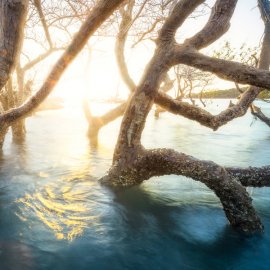The Money Cycle
-
English
-
ListenPause
[ [intro music] Welcome to World Ocean Radio… ] I’m Peter Neill, director of the World Ocean Observatory. Just this week, at OUR OCEAN, a recurring international gathering of governments and environmental organizations assembled on the small island nation of Palau, this year, according to its official final announcement amounting to 410 commitments across six issue areas as follows: Confronting the Ocean-Climate Crisis Creating Sustainable Blue Economies Advancing Sustainable Fisheries Advancing Marine Protected Areas for Communities, Ecosystems, and Climate Tackling Marine Pollution Achieving a Safe–Just and Secure Ocean The announcement continued, “Since 2014, the Our Ocean Conference has now mobilized more than 1,800 commitments worth approximately $108 billion toward ocean leadership and action.” This is an astonishing amount of money being financed by donor nations and organizations that one would think would insist on an equally astonishing demonstration of progress in ocean protection, mitigation, conservation, and best practice. I tried to dive deeper into the details, into some more precise indication of where the committed funds will go, toward what specific programs and agencies, and with what guidelines, standards, evaluation methods, and post commitment reports that would offer some measure of past success and future expectation. If that information was there, I could not find it. I listened to many commitment announcement speeches – limited to a few minutes, terse, general, in many cases referring to wind power investment and other substantial initiatives that factor large in the financial profiles of the donor nations and the concept of a “blue economy,” but only tangentially link to specific actions for serious regulatory change or rejuvenative redress coastwise and in the ocean. For example, one of the most pervasive strategies for climate mitigation on land is the planting of trees. There are projects worldwide with literally millions, allegedly trillions of trees being planted in cities and previously deforested areas, presented as natural instruments for CO2 sequestration, paid for by similar grants, similarly justified in the context of the UN Sustainable Development Goals and fulfillment of similar declarations. The trees of the ocean are mangroves and kelp. Kelp is primarily vulnerable to changing ocean temperature, pollutants in the water column, and destruction as species habitat. Mangroves are vulnerable to coastal development, human industrial waste, agriculture and fertilizer, and erosion from storm and tsunami. As mangrove forests are now seen for their original value as natural protection from all these factors, the irony of their destruction is now augmented by many replanting initiatives in the name of climate change reaction, funded by the same environmental protection interests and grant programs as those just re-committed. Historically, we destroyed mangrove forests to create new profitable landside uses – roads, resorts and shrimp ponds for example – and now we are reconstructing mangrove forests as mitigation for that damage done as solution for the problem created. How does this make sense? And what’s worse is that there are now growing reports that a very large number of these mangrove reforestation projects have failed due to poor planning, incompetent planting, recalcitrant residual competing interests, untreated sanitation, mismanagement and corruption. What’s going on here? There are so many questions. Are these announced commitments simply bravura? False promises? Ill-considered? Misdirected? Where does all that money go? What have past commitments achieved? How are outcomes measured? As an outsider, I look at the complexity and financial significance of these endeavors, and compare them to my sense of accomplishment, of the collective success of all this investment, of the seemingly intractable, inevitable decline that we see in biodiversity protection and sustainability, on land, in the air, in the water. We are not moving forward despite all these billions of dollars invested. Our ocean continues to decline. What are we missing? Why? Is there another way that we have not yet invented? What must we change to change our strategy for climate change? We will discuss these issues, and more, in future editions of World Ocean Radio. World Ocean Radio is distributed by the public radio exchange and the pacifica network for use by college and community radio stations worldwide. Find us wherever you listen to your favorite podcasts and at world ocean observatory dot org. [outro music]
This week on World Ocean Radio we're talking about the latest OUR OCEAN Conference in Palau and the contradiction of mangrove protection and invested monies for environmental protection interests. What happens with all the promises made at OUR OCEAN? Where does the money go? What have past commitments achieved and how are outcomes measured?
About World Ocean Radio
Peter Neill, Director of the World Ocean Observatory and host of World Ocean Radio, provides coverage of a broad spectrum of ocean issues from science and education to advocacy and exemplary projects. World Ocean Radio, a project of the World Ocean Observatory, is a weekly series of five-minute audio essays available for syndicated use at no cost by college and community radio stations worldwide.
World Ocean Radio is produced in association with WERU-FM in Blue Hill, Maine and is distributed worldwide by the Public Radio Exchange and the Pacifica Network.
Available for podcast download wherever you listen to your favorites.
Image
Gaby Barathieu / Ocean Image Bank
Resource
Our Ocean Conference 2022 Palau
https://ourocean2022.pw/
- Login to post comments



